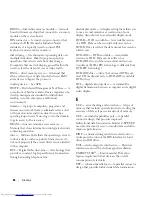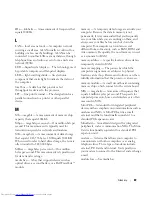
72
Glossary
ScanDisk — A Microsoft utility that checks files,
folders, and the hard disk’s surface for errors.
ScanDisk often runs when you restart the computer
after it has stopped responding.
SCSI — small computer system interface — A high-
speed interface used to connect devices to a
computer, such as hard drives, CD drives, printers,
and scanners. The SCSI can connect many devices
using a single controller. Each device is accessed by an
individual identification number on the SCSI
controller bus.
SDRAM — synchronous dynamic random-access
memory — A type of DRAM that is synchronized
with the optimal clock speed of the processor.
serial connector — An I/O port often used to connect
devices such as a handheld digital device or digital
camera to your computer.
Service Tag — A bar code label on your computer
that identifies your computer when you access Dell
Support at
support.dell.com
or when you call Dell for
customer service or technical support.
setup program — A program that is used to install
and configure hardware and software. The setup.exe
or install.exe program comes with most Windows
software packages. Setup program differs from system
setup.
shortcut — An icon that provides quick access to
frequently used programs, files, folders, and drives.
When you place a shortcut on your Windows desktop
and double-click the icon, you can open its
corresponding folder or file without having to find it
first. Shortcut icons do not change the location of
files. If you delete a shortcut, the original file is not
affected. Also, you can rename a shortcut icon.
smart card — A card that is embedded with a
processor and a memory chip. Smart cards can be
used to authenticate a user on computers equipped
for smart cards.
S/PDIF — Sony/Philips Digital Interface — An audio
transfer file format that allows the transfer of audio
from one file to another without converting it to and
from an analog format, which could degrade the
quality of the file.
standby mode — A power management mode that
shuts down all unnecessary computer operations to
save energy.
Strike Zone™ — Reinforced area of the platform base
that protects the hard drive by acting as a dampening
device when a computer experiences resonating shock
or is dropped (whether the computer is on or off).
surge protectors — Prevent voltage spikes, such as
those that may occur during an electrical storm, from
entering the computer through the electrical outlet.
Surge protectors do not protect against lightning
strikes or against brownouts, which occur when the
voltage drops more than 20 percent below the normal
AC-line voltage level.
Network connections cannot be protected by surge
protectors. Always disconnect the network cable from
the network connector during electrical storms.
SIM — Subscriber Identity Module. A SIM card
contains a microchip that encrypts voice and data
transmissions. SIM cards can be used in phones or
portable computers.
SVGA — super-video graphics array — A video
standard for video cards and controllers. Typical
SVGA resolutions are 800 x 600 and 1024 x 768. The
number of colors and resolution that a program
displays depends on the capabilities of the monitor,
the video controller and its drivers, and the amount of
video memory installed in the computer.
S-video TV-out — A connector used to attach a TV or
digital audio device to the computer.
SXGA — super-extended graphics array — A video
standard for video cards and controllers that supports
resolutions up to 1280 x 1024.






































